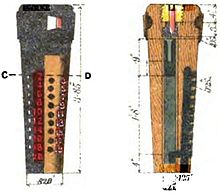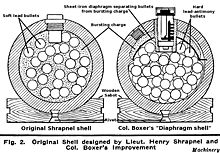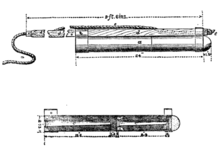Edward Mounier boxer
Edward Mounier Boxer ( February 1822 in Dover - January 2, 1898 in Ryde on the Isle of Wight ) was a British officer and inventor in the field of weapons technology . Among other things, he improved fuses and grenades ; He is best known for the invention of the boxer ignition for central fire cartridges named after him .
Life
Edward Mounier Boxer's father was the Royal Navy Admiral Edward Boxer . At fifteen, Boxer joined the British Army as a cadet and graduated in 1939. Originally he wanted to join the Royal Engineers , the engineering corps . Instead, he was placed in the service of the Royal Artillery , the artillery force , in December 1839 . From 1841 to 1842 he was stationed in Malta . In 1843, as a young officer , Boxer married Eleanor Charlotte Frances Payne, daughter of an officer in the Royal Artillery. From 1847 he was an instructor in fortress construction at the Royal Military Academy Woolwich . Early in his career he was interested in improvements to weapons technology, even if the military's support was limited due to the relatively long period of peace . In his role as an instructor he wrote a standard work on artillery. While still an instructor, he made thousands of shrapnel grenades improved according to his design on his own initiative. At least now his abilities were recognized. On April 13, 1854, he became a fireworker in the Royal Laboratories ammunition laboratory at the Royal Arsenal in London . His technical understanding led him to take over the management of the Royal Laboratories in June 1855. He built new production facilities, established a foundry and pushed ahead with mechanization . He was also a member of the Ordnance Select Committee, a committee for the procurement of armaments for the British Army. In 1868 he was promoted to colonel .
Boxer got into a dispute with the War Office as to whether he was allowed to register his patents or whether he was allowed to make financial profit from them. He would have made the inventions in his service as head of the ammunition laboratory ( employee invention ). The dispute already existed under Secretary of War John Pakington . In 1857, Boxer received financial compensation from War Office for his early inventions during the Crimean War. However, for late inventions, the War Office declined to reward boxers in addition to their salaries. Boxer agreed on license fees directly with the ammunition manufacturer Eley Brothers . This was a thorn in the side of the War Department. The War Office proposed a raise for Boxer if he waived the royalties. Boxer turned down the suggestion. The dispute escalated under the next British Secretary of War, Edward Cardwell, when the boxer asked about the Eley Brothers royalties. Boxer took the view that his patents and the profits from them were private. Cardwell took the answer as insubordination and asked for Boxer's resignation , which Boxer then submitted. In addition, there were allegations that Boxer had only slightly changed patents of others and passed them off as his own ideas. This dispute was fought in public and in court and also preoccupied the UK Parliament . Boxer left the army in December 1869 with the rank of major general . In 1870 Boxer published the pamphlet Colonel Boxer and the War Office as a one-sided personal statement.
Boxer's son, Edward William Frederick Boxer, was a naval officer and died in the sinking of the HMS Captain in September 1870.
Inventions
Adjustable time fuse for grenades
In 1849 Boxer developed an adjustable time fuse. In wooden body were a column with the incendiary, and two powder-filled channels from which outwardly diverged several numbered openings drilled. The openings, closed with whistle clay, were numbered and corresponded to the time until the detonator was triggered. Before the detonator was inserted into the grenade, one of these openings was drilled so that after the charge had burned up to the height of the opening in question, the flame could reach the explosive charge directly via the fire control channel. The lighting of the incendiary column was secured by a cap, which had to be removed before loading the grenade. The incendiary tube was connected to the fire control ducts at the bottom to ensure that the detonator ignites after the maximum time has been reached. The detonator was in contact with the explosive charge in the grenade; the pilot flame came out of the bottom of the fuse and ignited the explosive.
In order to set the detonator for the desired time, the corresponding hole had to be drilled. Setting the process with the detonator and inserting it into the projectile takes about 15 seconds.
The boxer time fuse was introduced in 1855. The detonator solved many problems in connection with time detonators and replaced the time detonators used until then. He was reliable and remained in service for many years.
Diaphragm shrapnel
Boxer was concerned with improvements to shrapnel grenades in 1849 . After a successful test, he suggested the diaphragm shrapnel in May 1852. In the original shrapnel grenade, the metal balls were embedded in the explosives. In some cases, this led to the explosive exploding prematurely, as friction could arise between the metal balls when it was fired . Boxer's idea was to separate the explosives from the metal balls with a partition (diaphragm). The explosives were not in the center, but on one side to distribute the metal balls as uniformly as possible. The opening was secured by predetermined breaking points in the shell.
This type of shrapnel grenade was introduced in 1855.
Parachute flares
In 1850 Boxer developed a flare grenade . This consisted of two spherical half-shells made of thin wrought iron. The lower half-shell contained a brightly burning mixture of saltpeter, sulfur and red auripigment , the upper half-shell contained a parachute to which the half-shell with the flare was attached with chains. In addition, a small explosive device with a time fuse was installed to dismantle the half-shells. The grenade was fired from a mortar; the timer should be set so that it ignited the explosive device when the highest point was reached. The explosive device ripped open the outer shell. The heavy half-shell with the flare fell down faster than the rest and unfolded the parachute. The burn time was 1–3 minutes.
Rescue missile
At the beginning of the Crimean War (1853) he developed the Congreve rocket further. However, the improvements had little practical use; In 1866 the British Army withdrew war missiles from use. The rocket, on the other hand, was used from the late 1860s as a rescue device for ships near the coast in distress. With the rocket, a lifeline could be fired from the bank to the wrecked ship. It was a two-stage missile with a central stabilizing rod. Boxer's rocket was used until the 1940s, after which it was replaced by lighter and more portable systems.
Bullet lubrication
During the Indian Rebellion of 1857 it became clear that the projectile lubrication in Enfield Rifled Musket was inadequate. In the hot climate, the sebum of the lubricant melted . Boxer suggested lubrication with pure beeswax .
Initiation of the time fuse by acceleration
The technical development of the artillery required a further development of the time fuse, which Boxer succeeded in 1863. Grenades for muzzleloaders were initiated when firing, in which fuses located outside and leading into the grenade were ignited by the explosion of the propellant charge. The breech-loading shells seal the barrel so well that no explosive flame can reach the front of the grenade's detonator. Boxer therefore developed an initiation based on the mass moment of inertia , because the grenade is strongly accelerated when it is fired . In the detonator was a weight, the hammer, hung with a wire. When it was fired, the wire tore and the hammer struck a percussion cap , the explosion flame of which started the time fuse. A safety pin, which had to be removed before launch, prevented an accidental explosion. Otherwise, the time fuse essentially corresponded to the boxer time fuse for muzzle-loaders.
Center fire cartridge with wound case and boxer ignition

In 1864 the British government decided to convert the Enfield Rifled Musket into a modern breech- loader Snider-Enfield Rifle . Boxer developed the .577 Snider cartridge for this purpose . The shell of the cartridge was made of wrapped brass sheet with paper pasted on the outside. The center fire ignition with the boxer ignition was housed in the case base. The boxer ignition sits in a recess in the bottom of the cartridge. A concave plate acts as an abutment against which the firing pin presses the bang. The abutment is an integral part of the primer cap. Boxer obtained two patents in the UK; No. 137 of January 15, 1866 and No. 2653 of October 13, 1866. In the USA he had the cartridge protected with patent 91,818 in 1869. While the wound sleeve was replaced by a solid sleeve after a few years, the boxer ignition is still used.
Breech-loading shrapnel
At the World Exhibition in Paris in 1867 , Boxer's design for a shrapnel that could be fired from a drawn breech-loader was presented. The explosive charge was in the bottom of the grenade and did not cause any additional scattering, but instead drove the projectiles out of the grenade and thus gave them additional acceleration. The spark to ignite the explosive charge came through a tube from the time fuse on the head ( "spit-back" principle ).
bibliography
- Treatise on Artillery, prepared for the use of the Practical Class, Royal Military Academy , 1859 [29]
- Memorandum on Shrapnel Shells in: Journal of the Royal Artillery , 1861 [30]
- Remarks on the System of Ordnance , 1862 [31]
- Colonel Boxer and the War office , 1870 [32]
Individual evidence
- ↑ a b c d e f Daniel R. LeClair: Supervising a revolution: British ordnance committees, private inventors, and military technology in the Victorian era , University of Houston , 2015, pp. 105, 121, 157 [1]
- ↑ a b c d e f g Obituary in: The Engineer , January 7, 1898, p. 8
- ↑ a b c Lance Day, Ian McNeil (Ed.): Biographical Dictionary of the History of Technology , Verlag Routledge , 2002, ISBN 9781134650200 , p. 161 [2]
- ↑ Annual Register Verlag J. Dodsley, 1844, p. 204 [3]
- ↑ Oliver Frederick Gillilan Hogg: The Royal Arsenal: Its Background, Origin, and Subsequent History, Volume 2 , Verlag Oxford University Press , 1963, p. 1266 [4]
- ↑ Papers relating to the dismissal of Colonel Boxer in Accounts and Papers of the House of Commons , 1870 [5]
- ↑ The case of Colonel Boxer in: The Saturday Review of Politics, Literature, Science and Art , May 7, 1870, p. 605 [6]
- ↑ a b c Manfred R. Rosenberger, Katrin Hanné: From the powder horn to the rocket projectile: The history of small arms ammunition. Motorbuch Verlag, 1993, ISBN 3613015412 , pp. 108-109, 141-142, 231
- ^ The Engineer , August 30, 1867, pp. 183-184 [7]
- ↑ RS France: Government Bamboozled: A Pamphlet Showing the Scandals of Woolwich Arsenal and Their Influence Upon the Home Office Verlag AT Atkinson, 1873 [8]
- ↑ Dauril Alden, James S. Cummins, Michael Cooper: Charles R. Boxer: an uncommon life: soldier, historian, teacher, collector, traveler , Verlag Fundação Oriente, 2001 p. 30 [9]
- ↑ Annual Register Verlag J. Dodsley, 1871, p. 337 [10]
- ↑ Oliver Frederick Gillilan Hogg: Artillery: its origin, heyday, and decline , Verlag Archon Books, 1970, ISBN 9780208010407 , p. 186 [11]
- ↑ Josef Ritter von Eschenbacher: About modern artillery , Bernhard Friedrich Voigt Verlag , 1872, p. 23 [12]
- ↑ The United Service Magazine , Verlag Hurst and Blackett, 1856, p. 194 [13]
- ^ William Ruxton Barlow (Ed.): Notes on ammunition , Issue 4, Her Majesty's Stationery Office , 1877 [14]
- ↑ Experiments with Naval Ordnance: HMS “Excellent”. Harrison & Sons, 1866, p. 35 [15]
- ^ WY Carman: A History of Firearms: From Earliest Times to 1914 , 1955, ISBN 9781317411154 (reprint) p. 138 [16]
- ^ Journal of the Royal Artillery, Volume 2, Verlag Royal Artillery Institution, 1861 [17]
- ↑ a b The technical educator, an encyclopædia, Volume 1 , 1884, Verlag Cassell & Co, pp. 8-10 [18]
- ^ Charles Bormann: The Shrapnel Shell in England and in Belgium ... A historico-technical sketch , Verlag Louis Truyts, 1862, pp. 10-12. [19]
- ↑ Jon Excell: Illuminating the enemy in: The Engineer 16 December 2010
- ↑ James Earle: Commodore Squib: The Life, Times and Secretive Wars of England's First Rocket Man, Sir William Congreve, 1772-1828 , Cambridge Scholars Publishing, 2009, ISBN 9781443818155 , p. 237 [20]
- ^ A. Bowdoin Van Riper: Rockets and Missiles: The Life Story of a Technology , Verlag Johns Hopkins University Press , 2007, ISBN 9780801887925 , p. 23 [21]
- ^ The Parliamentary Debates, Great Britain , Verlag R. Bagshaw, 1870, p. 2063 [22]
- ^ The technical educator, an encyclopædia, Volume 1 , 1884, Verlag Cassell & Co, p. 66 [23]
- ↑ Experiments with Naval Ordnance , Verlag Harrison & Sons, 1866 p. 36 [24]
- ↑ Charles Orde Browne: amunition for rifled ordnance. Volume 1, Secretary of State for War , 1870, pp. 144–146 [25]
- ↑ Gerald Prenderghast: Repeating and Multi-Fire Weapons: A History from the Zhuge Crossbow Through the AK-47 , McFarland Verlag, 2018, ISBN 9781476631103 , p. 88 [26]
- ↑ Great Britain Patent Office: Subject-matter Index of Patents Applied for and Patents Granted, for the Year 1866 , 1867, p. 63 [27]
- ↑ Reports on the Paris universal exhibition, 1867, Volume 4 , 1868, p. 135 [28]
| personal data | |
|---|---|
| SURNAME | Boxer, Edward Mounier |
| BRIEF DESCRIPTION | British officer and inventor in the field of weapons technology |
| DATE OF BIRTH | February 1822 |
| PLACE OF BIRTH | Dover |
| DATE OF DEATH | January 2, 1898 |
| Place of death | Ryde on Isle of Wight |







